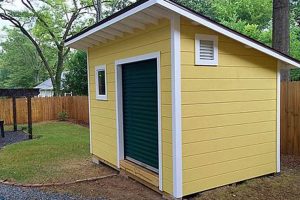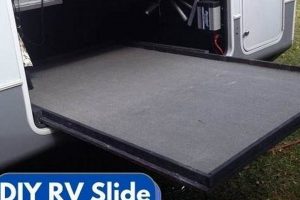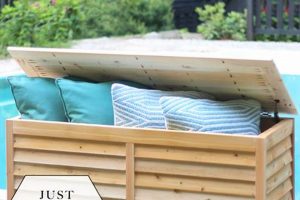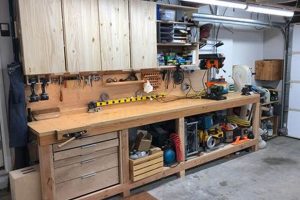Structures designed for external storage, delivered as unassembled components accompanied by instructions for self-assembly, represent a prevalent method for homeowners to expand storage capacity. These packages typically include pre-cut lumber, roofing materials, hardware, and detailed assembly manuals, enabling individuals to construct a functional storage unit without extensive carpentry experience. For instance, a property owner might acquire a package to house gardening equipment, seasonal decorations, or outdoor tools.
The appeal of these systems lies in their cost-effectiveness and the element of customization afforded to the purchaser. Selecting and assembling such a unit often proves more economical than contracting a professional builder to construct a bespoke storage building. Furthermore, the modular nature of these packages allows for a degree of personalization regarding size, layout, and aesthetic features. Historically, the rise in popularity of these systems correlates with an increase in suburban homeownership and a concurrent demand for supplementary storage solutions.
The following sections will delve into the considerations surrounding the selection of an appropriate storage structure, covering aspects such as material choices, foundation options, and relevant building codes. This information aims to provide a comprehensive overview of the factors influencing the successful implementation of an external storage solution.
Tips for Successful Assembly
Careful planning and execution are paramount when undertaking the construction of an external storage structure. Adhering to established best practices will contribute to a durable and functional outcome.
Tip 1: Site Preparation is Crucial: Before commencing assembly, ensure the chosen location is level, stable, and appropriately drained. Inadequate site preparation can lead to structural instability and premature deterioration of the structure.
Tip 2: Inventory All Components: Upon delivery, meticulously inventory all included components against the provided parts list. Addressing any discrepancies before assembly commences mitigates potential delays and frustration.
Tip 3: Adhere Strictly to the Assembly Instructions: The provided instructions represent a critical guide. Deviations from the prescribed sequence or methods may compromise structural integrity and invalidate any warranties.
Tip 4: Utilize Appropriate Tools: Employing the correct tools, such as levels, squares, and power drills with appropriate bits, ensures precise assembly and minimizes the risk of damage to the components.
Tip 5: Prioritize Weather Protection: During assembly, protect exposed lumber from rain or excessive sunlight. Applying a sealant or primer to cut edges can further enhance weather resistance.
Tip 6: Secure a Proper Foundation: A solid foundation is essential for long-term stability. Depending on local codes and site conditions, consider options such as concrete slabs, gravel pads, or pressure-treated lumber foundations.
Tip 7: Ensure Adequate Ventilation: Proper ventilation helps prevent moisture buildup and prolongs the life of the structure. Consider installing vents or ensuring sufficient airflow to minimize condensation.
Following these guidelines contributes significantly to the successful assembly of a durable and functional external storage solution, maximizing its utility and longevity.
The subsequent section will discuss potential challenges encountered during the assembly process and offer strategies for effective problem-solving.
1. Material Durability
The longevity and functionality of external storage structures are inextricably linked to the durability of the materials used in their construction. Premature degradation of materials in diy storage shed kits necessitates costly repairs or complete replacement, thereby negating the initial cost savings associated with self-assembly. Material selection, therefore, directly impacts the long-term value proposition of such a purchase. For example, a kit constructed with untreated lumber and inadequate roofing will be susceptible to rot, insect infestation, and water damage, particularly in regions with high humidity or extreme weather conditions. The subsequent structural compromise leads to potential collapse or the inability to securely store intended items.
Conversely, utilizing materials engineered for enhanced durability, such as pressure-treated lumber, composite siding, or metal roofing, significantly extends the lifespan of the assembled structure. While the initial investment may be higher, the reduced maintenance requirements and prolonged resistance to environmental stressors provide a demonstrable return on investment. Consider the case of a homeowner in a coastal area who chooses a kit featuring galvanized steel framing and composite siding. This material selection provides superior resistance to corrosion from saltwater and prevents deterioration from prolonged sun exposure, resulting in a storage solution that withstands harsh marine conditions. The absence of routine painting or repairs further minimizes ongoing maintenance costs.
In conclusion, prioritizing material durability when selecting a diy storage shed kit is paramount for ensuring a structurally sound and long-lasting external storage solution. The choice of materials directly affects the structure’s ability to withstand environmental challenges, resist pests, and provide secure storage over an extended period. Neglecting this aspect can lead to significant financial and practical burdens in the long run, highlighting the importance of careful evaluation and selection of materials engineered for longevity and performance.
2. Foundation Requirements
The integrity and longevity of any external storage structure, particularly those assembled from diy storage shed kits, are inextricably linked to the adequacy of its foundation. The foundation serves as the critical interface between the structure and the ground, distributing the weight of the building and its contents evenly. Improper or inadequate foundation preparation can lead to a cascade of detrimental effects, ranging from structural instability and accelerated material degradation to complete failure of the unit. For instance, a diy storage shed kits erected on unstable soil without proper leveling may experience settling, resulting in warped walls, misaligned doors, and compromised roofing. The absence of a moisture barrier within the foundation can promote wicking of ground moisture into the structure’s wood framing, creating an environment conducive to rot and mold growth. The practical significance of understanding foundation requirements lies in the prevention of these adverse outcomes and the assurance of a durable and functional storage space.
Foundation options for diy storage shed kits vary depending on the size of the structure, local building codes, and site conditions. Smaller units may suffice with a simple gravel pad, providing drainage and a level surface. Intermediate-sized structures often benefit from a foundation of pressure-treated lumber resting on concrete blocks, offering a stable and elevated platform. Larger or more permanent storage solutions may necessitate a full concrete slab foundation, providing maximum support and resistance to settling. The choice of foundation should be informed by a thorough assessment of the site’s soil composition, drainage characteristics, and potential frost heave. Compliance with local building codes is paramount, as many jurisdictions mandate specific foundation requirements for structures exceeding a certain size or intended for permanent use. Neglecting these regulations can result in fines, mandatory removal of the structure, and potential legal liabilities.
In summary, adherence to appropriate foundation requirements represents a fundamental aspect of successfully implementing a storage solution using diy storage shed kits. The foundation not only provides structural support but also protects the structure from moisture damage and ensures compliance with local building codes. While seemingly straightforward, the process demands careful planning, accurate site preparation, and a selection of materials appropriate for the specific environmental conditions. Challenges associated with foundation construction, such as uneven terrain or restrictive building codes, necessitate a thorough understanding of the available options and a willingness to adapt the chosen approach to meet the unique demands of the project. A solid foundation is, therefore, a cornerstone of a reliable and long-lasting storage building.
3. Assembly Complexity
The inherent complexity of assembling diy storage shed kits directly impacts the time investment, skill requirements, and ultimate success of the project. A higher degree of assembly complexity necessitates more specialized tools, a greater understanding of construction principles, and a longer completion timeframe. Kits characterized by intricate designs, numerous components, or ambiguous instructions often pose a significant challenge for individuals with limited carpentry experience. This can lead to frustration, errors in construction, and potentially compromise the structural integrity of the finished product. Conversely, kits designed with simplified assembly processes, clear instructions, and pre-assembled components minimize the risk of errors and accelerate the construction timeline. The selection of a diy storage shed kits should therefore be predicated on a realistic assessment of the assembler’s skill level and available resources.
The correlation between assembly complexity and user experience is readily apparent in real-world examples. A homeowner with minimal construction experience might opt for a simple, pre-fabricated kit with interlocking panels and pre-drilled holes. This minimizes the need for precise measurements, cutting, or intricate fastening techniques. Conversely, a seasoned carpenter might choose a more complex kit featuring custom-cut lumber and detailed architectural elements. The practical significance of understanding assembly complexity extends to cost considerations. While simpler kits may be more expensive upfront, the reduced labor required for assembly can offset the initial cost difference. Conversely, complex kits may appear more economical initially, but the need for professional assistance to complete the assembly can significantly increase the overall project cost. An informed assessment of assembly complexity, therefore, enables a more accurate determination of the total cost of ownership.
In summary, assembly complexity is a critical factor to consider when evaluating diy storage shed kits. A mismatch between the assembler’s skill level and the kit’s complexity can lead to frustration, errors, and increased costs. Prioritizing clear instructions, simplified assembly processes, and pre-assembled components is essential for ensuring a successful project outcome. While more complex kits may offer greater customization options or aesthetic appeal, a realistic assessment of one’s capabilities and resources is paramount. The selection of a diy storage shed kits should ultimately reflect a balance between desired features, assembly complexity, and overall project feasibility.
4. Permitting Regulations
The construction of external storage structures, including those derived from diy storage shed kits, is frequently subject to local permitting regulations. These regulations are established by municipal or county authorities to ensure compliance with building codes, zoning ordinances, and safety standards. Understanding and adhering to these regulations is a crucial aspect of any storage building project, potentially affecting the project’s feasibility, timeline, and overall cost.
- Size and Height Restrictions
Many jurisdictions impose restrictions on the maximum size and height of accessory structures, including sheds. These restrictions may vary depending on the property’s zoning designation and its proximity to property lines. A diy storage shed kits exceeding these limits may require a variance or be subject to rejection. For example, a homeowner in a residential zone might be limited to a shed no larger than 120 square feet and no taller than 10 feet at its peak. Failure to comply can result in fines or the forced removal of the structure.
- Setback Requirements
Setback requirements dictate the minimum distance a structure must be located from property lines, easements, and other designated areas. These requirements are designed to preserve property rights, prevent encroachments, and ensure adequate access for utilities and emergency services. diy storage shed kits placed in violation of setback requirements may be subject to legal action and mandated relocation. Consider a scenario where a homeowner mistakenly positions a shed within a utility easement; the municipality may require the shed to be moved at the homeowner’s expense.
- Building Codes and Structural Integrity
Building codes establish minimum standards for structural integrity, safety, and durability. These codes often specify requirements for foundation construction, framing materials, roofing systems, and electrical wiring. diy storage shed kits must be constructed in accordance with applicable building codes to ensure the safety of occupants and prevent potential hazards such as collapse or fire. For example, a building code might specify the use of pressure-treated lumber for all components in contact with the ground to prevent rot and insect infestation.
- Easements and Restrictive Covenants
Easements grant specific rights to third parties to use a portion of a property for designated purposes, such as utility lines or drainage. Restrictive covenants are private agreements that limit the use of property within a specific subdivision or community. diy storage shed kits erected within an easement or in violation of a restrictive covenant may be subject to removal. A homeowner should review property deeds and consult with local authorities to identify any existing easements or covenants before commencing construction.
In conclusion, adherence to permitting regulations is an indispensable aspect of any project involving diy storage shed kits. Failure to comply with these regulations can result in costly fines, legal action, and the forced removal of the structure. Thoroughly researching local requirements, submitting appropriate permit applications, and adhering to all applicable codes is essential for ensuring a successful and legally compliant project outcome. The complexities of permitting regulations often necessitate consultation with local building officials or experienced contractors, particularly for individuals unfamiliar with the regulatory landscape.
5. Cost Considerations
The acquisition of diy storage shed kits is often motivated by the prospect of cost savings relative to professionally constructed alternatives. However, a comprehensive evaluation of associated expenses extends beyond the initial purchase price of the kit. The total cost of ownership encompasses a spectrum of factors, including site preparation, foundation materials, assembly tools, permit fees, and potential expenses arising from unforeseen challenges or necessary modifications. The failure to account for these ancillary costs can negate the perceived economic advantage of diy storage shed kits, potentially leading to budgetary overruns and project delays. For instance, a homeowner selecting a seemingly inexpensive kit may subsequently discover the need for extensive site leveling, specialized tools, or professional assistance in navigating complex assembly instructions. The cumulative impact of these unforeseen expenses can significantly increase the total project cost, rendering the diy storage shed kits a less economically viable option.
Material choices within the kit itself also exert a considerable influence on the overall cost. Kits constructed with premium materials, such as pressure-treated lumber or metal roofing, generally command a higher initial price compared to those utilizing less durable alternatives. However, the increased longevity and reduced maintenance requirements associated with higher-quality materials often translate into long-term cost savings. Consider the example of two identical diy storage shed kits, one constructed with untreated lumber and the other with pressure-treated lumber. The former may be less expensive initially, but its susceptibility to rot and insect infestation necessitates frequent repairs or eventual replacement. The latter, while more expensive upfront, offers superior resistance to environmental degradation, thereby minimizing long-term maintenance costs and extending the structure’s lifespan. Moreover, the potential need for professional assistance during assembly represents a significant cost consideration. While some individuals possess the requisite skills and tools to complete the assembly process independently, others may require professional expertise to ensure structural integrity and compliance with local building codes. The cost of hiring a contractor to assemble the kit can substantially increase the total project expenditure, particularly for complex or time-consuming projects.
In conclusion, a thorough assessment of cost considerations is paramount when evaluating the viability of diy storage shed kits. The initial purchase price represents only one component of the overall project cost. Factors such as site preparation, foundation materials, assembly tools, permit fees, material choices, and potential professional assistance must be carefully considered to ensure an accurate assessment of the total cost of ownership. Neglecting these ancillary expenses can lead to budgetary overruns and undermine the perceived economic advantages of diy storage shed kits. A comprehensive cost analysis, incorporating both upfront and long-term expenses, enables informed decision-making and facilitates the selection of a storage solution that aligns with budgetary constraints and performance expectations.
Frequently Asked Questions Regarding DIY Storage Shed Kits
This section addresses common inquiries and misconceptions concerning self-assembled external storage structures, offering detailed explanations to facilitate informed decision-making.
Question 1: What structural certifications, if any, should one seek when purchasing DIY storage shed kits to ensure compliance with building codes?
Compliance with local building codes is paramount. Look for kits displaying certifications from reputable engineering organizations, indicating adherence to wind load, snow load, and seismic requirements specific to the purchaser’s geographical location. Documentation should be available for review prior to purchase.
Question 2: How does the absence of professional installation impact the warranty of DIY storage shed kits, and what steps can be taken to mitigate potential warranty issues?
Many manufacturers stipulate that proper assembly is a condition of warranty validity. Documenting each step of the assembly process with photographs and adhering strictly to the manufacturer’s instructions is advisable. Consultation with a qualified building inspector prior to, during, and after assembly can provide verification of code compliance and further protect the warranty.
Question 3: What are the long-term maintenance requirements for DIY storage shed kits constructed from various materials, such as wood, metal, or plastic, and how do these requirements impact the total cost of ownership?
Wood structures typically require periodic staining or painting to prevent rot and insect infestation. Metal structures may require rust prevention treatments, and plastic structures may be susceptible to UV degradation. A comprehensive maintenance schedule, factoring in material-specific requirements, should be developed to accurately assess the total cost of ownership.
Question 4: Are there specific tools or equipment recommended for the efficient and accurate assembly of DIY storage shed kits, and what is the estimated cost associated with acquiring these tools?
Essential tools include a level, square, power drill with various bits, measuring tape, hammer, and safety glasses. Depending on the complexity of the kit, a circular saw, reciprocating saw, and impact driver may also be necessary. The cost of acquiring these tools can range from several hundred to over a thousand dollars, depending on the quality and brand selected.
Question 5: How does the resale value of a property impact by the presence of a DIY storage shed kits, and what factors contribute to an increase or decrease in property value?
A well-constructed and properly maintained storage structure can enhance property value by providing additional storage space and improving curb appeal. Conversely, a poorly constructed or dilapidated structure can detract from property value. Factors such as aesthetics, functionality, compliance with building codes, and overall condition contribute to its impact on resale value.
Question 6: What are the potential legal ramifications associated with constructing DIY storage shed kits that violate local zoning ordinances or building codes?
Violations of local zoning ordinances or building codes can result in fines, legal action, and the forced removal of the structure. Prior to commencing construction, thoroughly researching local regulations and obtaining necessary permits is essential to avoid potential legal ramifications.
This FAQ section provides crucial information on common concerns related to DIY storage sheds.
The next section will summarize the information presented, offering key takeaways to guide decision-making regarding the acquisition and implementation of these storage solutions.
DIY Storage Shed Kits
This exploration has underscored the multifaceted considerations surrounding diy storage shed kits. Key aspects include material durability, foundation requirements, assembly complexity, permitting regulations, and comprehensive cost analysis. Successful implementation necessitates meticulous planning, diligent execution, and a thorough understanding of local ordinances. Neglecting any of these elements can compromise structural integrity, increase expenses, and potentially result in legal complications.
The decision to pursue a diy storage shed kits solution warrants careful deliberation. Assess needs realistically, research options thoroughly, and prioritize compliance with all applicable regulations. A well-informed approach ensures a storage solution that is both functional and sustainable, contributing positively to the property and its long-term value.




![DIY Storage: Tote Rack DIY Plans & Ideas [Easy!] The DIY Hub: Creative Crafts, Repairs & Life Hacks DIY Storage: Tote Rack DIY Plans & Ideas [Easy!] | The DIY Hub: Creative Crafts, Repairs & Life Hacks](https://craftingdiycenter.com/wp-content/uploads/2025/07/th-1813-300x200.jpg)


